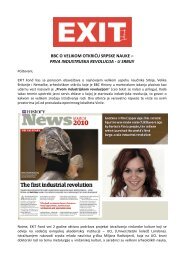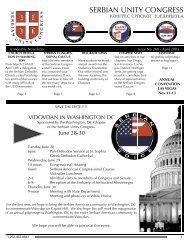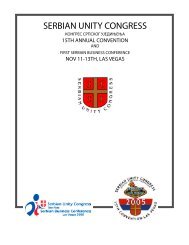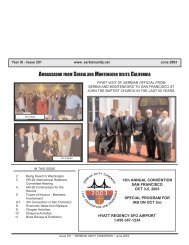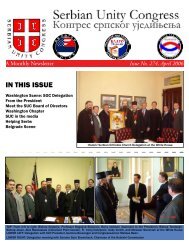BULLETIN - Serbian Unity Congress
BULLETIN - Serbian Unity Congress
BULLETIN - Serbian Unity Congress
You also want an ePaper? Increase the reach of your titles
YUMPU automatically turns print PDFs into web optimized ePapers that Google loves.
TRIP TO KOSOVO AND METOHIJA<br />
heavily armed escort of NATO troops to<br />
protect against Albanian attack.<br />
Having already recorded virtual libraries<br />
of the monasteries of Gracanica<br />
(gra-cha-nee-tsa) and Decani (de-chanee)<br />
our BLAGO (Treasure) team set out<br />
this summer for the Patriarchate of Pec<br />
(pech), a <strong>Serbian</strong> crown jewel and beacon<br />
of Christianity in Kosovo-and-Metohija.<br />
A single glance at the church complex<br />
and courtyard lets you know instantly<br />
why you have come. The essence of<br />
being <strong>Serbian</strong> and the repository of our<br />
nation’s collective memory is all rooted<br />
here in the history, Christianity, culture<br />
and architecture. Our project aims to<br />
share this window on our soul across the<br />
world, just as we cherish and admire the<br />
wonders of other nations’ historical treasuries.<br />
The Patriarchate of Pec, the historic<br />
seat of the patriarchs of the <strong>Serbian</strong><br />
Orthodox Church, is a complex of four<br />
churches built over the eras of a succession<br />
of monarchs and patriarchs starting<br />
around the year 1230 AD. The three<br />
main churches share a common narthex<br />
entry or lobby, while<br />
the fourth and smallest<br />
has a separate<br />
entrance. As the center<br />
of <strong>Serbian</strong> Christianity<br />
for ages, the<br />
complex is the final<br />
resting place of a parade<br />
of patriarchs and<br />
royals, their tombs<br />
and sarcophaguses<br />
tended by monastic under the dim light<br />
of candles burning across the millennia.<br />
It was in this surreal atmosphere, surrounded<br />
by the sweet smell of incense<br />
that we began our work. To avoid setting<br />
up major scaffolding but to still<br />
get the perspective needed<br />
to photograph the church, we<br />
used a remote-control camera<br />
mounted atop a 30-foot telescoping<br />
pole with a flash on<br />
a second pole. We raised the<br />
poles from a 10-foot pedestal<br />
that we had to build to reach<br />
the top of the main dome.<br />
Using the very latest digital<br />
photographic equipment, we<br />
worked from 42 virtual-reality<br />
observation points, taking 5,000 highresolution<br />
photos over seven days of<br />
work. The result is 100 gigabytes of data<br />
to be processed into a seamless virtual<br />
space that visitors around the world will<br />
stroll through in wonder, using the computer<br />
screens in their homes. We started<br />
our work right after each morning’s 9 AM<br />
service, continuing uninterrupted till as<br />
late as 2 AM the next<br />
morning.<br />
Each team member<br />
had a role: supporting<br />
and building<br />
the observation<br />
structures, checking<br />
the photos on screen,<br />
or writing down the<br />
details of each shot.<br />
In addition, our two experts in <strong>Serbian</strong><br />
medieval art put together a detailed history<br />
of each fresco as we went along.<br />
The nuns and others in the complex<br />
supported our efforts. A couple from the<br />
nearby <strong>Serbian</strong> village of Gorazdevac (gorazh-de-vats)<br />
prepared our meals in the<br />
finest tradition of first-class hosts typical<br />
of Serbia. Gorazdevac nestles quietly by<br />
the Bistrica (bis-tree-tsa) Stream where<br />
<strong>Serbian</strong> children frolicking in the water<br />
to cool off in a hot August four years ago<br />
were machine-gunned to death by an Albanian<br />
sniper hiding in the trees with an<br />
AK-47 automatic weapon. Their lifeless<br />
small bodies were given their last blessings<br />
in the glow of our other martyrs buried<br />
in the ancient patriarchate.<br />
Check our Web site www.srpskoblago.<br />
org for the images of our threatened heritage<br />
and please donate what you can to<br />
preserve it.<br />
This BLAGO (Treasure) team included<br />
Igor Jeremic, Zoran Jovanovic, Gordana<br />
Kojic, Ljubomir Medenica, Sasa Sekulic<br />
and Nenad Vukicevic.<br />
Negotiating for<br />
peace in Kosovo<br />
Washington Times, August 20,<br />
2007<br />
Dan Burton - In coming weeks, an<br />
international confrontation is likely to<br />
occur among the United States, the European<br />
Union, and Russia over an issue<br />
most Americans have long since forgotten:<br />
Kosovo, where a few hundred Americans<br />
remain deployed as part of a NATO<br />
force protecting a shaky interim peace<br />
that ended the 1999 U.S.-led intervention.<br />
For most Americans this obscure <strong>Serbian</strong><br />
province, with its mainly Albanian<br />
Muslim population and its hundreds of<br />
<strong>Serbian</strong> Christian churches and monasteries,<br />
may be a little-remembered footnote<br />
to the breakup of Yugoslavia. However,<br />
now is the time for clear thinking<br />
about next steps if Kosovo is to avoid revisiting<br />
its history as a hotbed of regional<br />
instability and violence.<br />
18 www.serbianunity.net<br />
<strong>Serbian</strong> <strong>Unity</strong> <strong>Congress</strong> Newsletter, No. 282, Summer 2007



